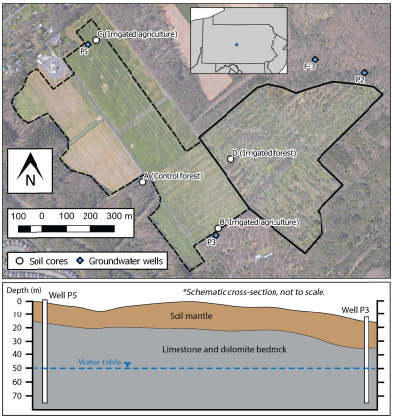2023-01-04 ペンシルベニア州立大学(PennState)
“PFAS(ペルフルオロアルキル物質)と呼ばれるこれらの化学物質は、非常に有用であるため、あらゆる場所で使用されてきました。”と、ペンシルベニア州立大学の博士候補としてこの研究を行った米国地質調査所の研究者、カレ・ジャーン氏は言います。「残念ながら、最小の分子レベルでは、自然環境ではそれ以上分解されないのです。もし、放出されれば、魚や他の動物に蓄積され、最終的には私たちにも蓄積されることになるのです。
科学者たちは、ペンシルバニア州センター郡の元消防士訓練センター付近の地下水に入り込んだ、そのような化学物質の一つであるパーフルオロオクタンスルホン酸(PFOS)を研究しました。PFOSは消火用発泡剤によく含まれる成分で、この消防訓練場では何十年にもわたって使用されていました。当時、この化学物質は規制されていませんでした。
PFOS分子は疎水性で有機炭素に付着し、岩盤帯水層の有機炭素の変動が地下水中の化学物質の濃度に影響を与える可能性があると、科学者は学術誌「Groundwater」に報告しました。
このサイトでは1990年代に修復が始まり、2000年以降、地下水のモニタリングが行われ、2015年からはPFASとPFOSの測定も行われています。2015年から2018年にかけて収集されたデータでは、地下水中のPFOSプルームが、訓練場付近と離れた場所の2つの濃度のピークを示し、2つのホットスポットの間では濃度が低くなっていたと、科学者たちは述べています。
現場での物理的な測定結果は、水位や透水係数(地下を流れる水の速さ)の変化が原因ではないことを示唆しています。しかし、岩盤のサンプルからは、有機炭素の含有量に大きなばらつきがあることがわかったという。PFOS分子は有機炭素や他の鉱物と容易に結合するため、有機炭素が多い場所では汚染物質の濃度が高くなる可能性があります。
「PFASをユニークにしているもの、つまり有用にしているものは、その化学構造であり、それが環境中での動きを予測することを難しくしているのです」とJahnは述べています。”ほとんど全てのPFASは、疎水性で、その分子構造の一部が、水の中にいることを嫌がり、そのために、有機物に付着します。”
科学者達は、PFASの流出や暴露現場の岩盤の有機炭素や他の鉱物濃度のばらつきを見つけることは、汚染物質がどこに蓄積し、どこでさらなる試験を行うべきかを対応者がより良く理解するのに役立つかもしれないと言いました。
<関連情報>
- https://www.psu.edu/news/research/story/study-sheds-light-how-forever-chemicals-travel-groundwater/
- https://agupubs.onlinelibrary.wiley.com/doi/10.1029/2022WR034321
排水再利用・地下水涵養システムにおけるパーフルオロアルキル酸(PFAA)の蓄積・輸送・動態 Storage, transport, and fate of perfluoroalkyl acids (PFAAs) in a wastewater re-use and groundwater recharge system
Kalle Jahn, Demian M Saffer, Katherine H Freeman, Sara Lincoln
Groundwater Published:December 22, 2022
DOI: 10.22541/essoar.167169847.70861531/v1

Abstract
Perfluoroalkyl acids (PFAAs), a group of synthetic compounds associated with adverse human health impacts, are commonly found in effluent discharged from wastewater treatment facilities. When that effluent is used for irrigation, the fate of PFAAs depends strongly on vadose zone solute retention properties and loading history. The relative importance of PFAA retention factors under natural conditions remains uncertain, and the historical record of effluent PFAA concentrations is limited. Using soil cores collected from the Penn State Living Filter (irrigated with treated wastewater effluent for nearly 60 years), we evaluated PFAA transport under near-natural conditions, and estimated historical PFAA concentrations in the irrigated effluent. Total perfluorooctanesulfonic acid (PFOS) and perfluorooctanoic acid (PFOA) masses stored in soils in 2014 were more than 450 times greater than the masses applied during the 2020 effluent irrigation. Equilibrium piston-flow transport models reproduced the observed PFOS and PFOA profiles, allowing us to estimate historical effluent PFOS and PFOA concentrations: 70-170 ng L-1 and 1000-1300 ng L-1, respectively. Estimated concentrations were comparable to concentrations measured in other wastewater effluents in the 1990s and 2000s, indicating that when interpreted with transport modeling, wastewater-irrigated soils function as integrated records of historical PFAA loading. Simulated PFOS breakthrough to groundwater occurred 50 years after the start of wastewater irrigation, while simulated PFOA breakthrough occurred after only 10 years of irrigation. Thus, while wastewater irrigation of soils facilitates retention and reduces effluent PFAA loading to surface waters, the resulting increased PFAA storage in soils potentially creates long-term sources of PFAAs to groundwater.



